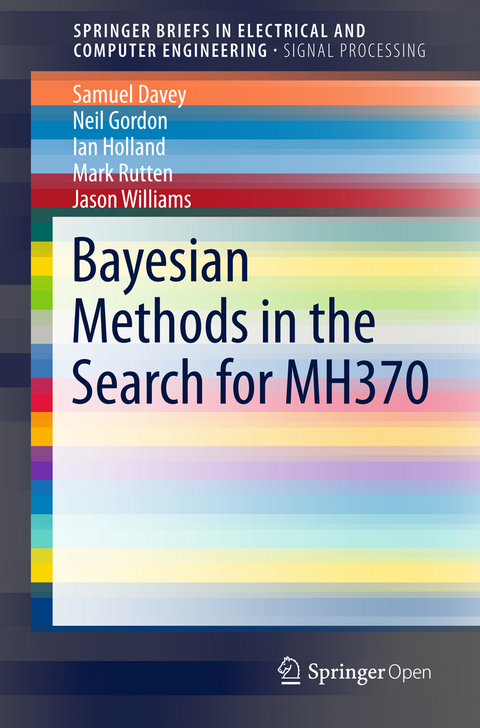
Bayesian Methods in the Search for MH370
Springer Verlag, Singapore
978-981-10-0378-3 (ISBN)
The book describes particle-filter based numerical calculation of the aircraft flight-path probability distribution and validates the method using data from several of the involved aircraft’s previous flights. Finally it is shown how the Reunion Island flaperon debris find affects the search probability distribution.
Samuel Davey received the Bachelor of Engineering, Master of Mathematical Science and PhD degrees from the University of Adelaide, Australia, in 1996, 1999, and 2003, respectively. Since 1995 he has worked for the Defence Science and Technology Group, Australia, in the areas of target tracking, tracker performance assessment, and multi-sensor fusion. He is a Visiting Research Fellow at the University of Adelaide and a Senior Member of the IEEE. Neil Gordon received a PhD in Statistics from Imperial College London in 1993. He was with the Defence Evaluation and Research Agency in the UK until 2002 working on missile guidance and statistical data processing. He is best known for initiating the particle filter approach to nonlinear, non-Gaussian dynamic estimation which is now in widespread use throughout the world in many diverse disciplines. He is the co-author/co-editor of two books on particle filtering. In 2002 he moved to the Defence Science and Technology Group in Adelaide, Australia where he is currently head of Data and Information Fusion. In 2014 he became an Honorary Professor with the School of Information Technology and Electrical Engineering at the University of Queensland. He is a Senior Member of the IEEE. Ian Holland received the Bachelor of Electronic and Communication Engineering in 2000 and a PhD in wireless telecommunications in 2005, both from Curtin University of Technology, Western Australia. Since then he has held positions in the University of Western Australia, the Institute for Telecommunications Research at the University of South Australia, EMS Satcom Pacific and Lockheed Martin Australia. Since January 2011, Ian has been working as a Research Scientist in Protected Satellite Communications at the Defence Science and Technology Group. Mark Rutten received theBachelor of Science, Bachelor of Engineering and Master of Mathematical Science from the University of Adelaide in 1995, 1996 and 1999, respectively and a PhD from the University of Melbourne in 2005 on Multipath Tracking for Over the Horizon Radars. He has worked on data and information fusion for the Defence Science and Technology Group since 1996. His research interests include nonlinear state estimation, target tracking and multi-sensor fusion. Jason Williams received degrees of Bachelor of Engineering in Electronics andBachelor of Information Technology from Queensland University of Technology in 1999, Master of Science in Electrical Engineering from the United States Air Force Institute of Technology in 2003, and PhD in Electrical Engineering and Computer Science from Massachusetts Institute of Technology in 2007. He worked for several years as an engineering officer in the Royal Australian Air Force, before joining Australia’s Defence Science and Technology Group in 2007. He is also an Adjunct Senior Lecturer at the University of Adelaide. His research interests include target tracking, sensor resource management, Markov random fields and convex optimisation.
Introduction.- Factual Description of Accident and Available Information.- Bayesian Approach.- Inmarsat Satellite Communication System.- Aircraft Cruise Dynamics.- Aircraft Maneuver Dynamics.- Particle Filter Implementations.- Validation Experiments.- Application to MH370 Accident.- Incorporating Search Data.- Conclusions.
| Erscheinungsdatum | 09.03.2016 |
|---|---|
| Reihe/Serie | SpringerBriefs in Electrical and Computer Engineering |
| SpringerBriefs in Electrical and Computer Engineering | |
| SpringerBriefs in Signal Processing | SpringerBriefs in Signal Processing |
| Zusatzinfo | 2 Illustrations, color; 49 Illustrations, black and white; XVI, 114 p. 51 illus., 2 illus. in color. |
| Verlagsort | Singapore |
| Sprache | englisch |
| Maße | 155 x 235 mm |
| Themenwelt | Mathematik / Informatik ► Informatik ► Theorie / Studium |
| Mathematik / Informatik ► Mathematik ► Angewandte Mathematik | |
| Mathematik / Informatik ► Mathematik ► Computerprogramme / Computeralgebra | |
| Mathematik / Informatik ► Mathematik ► Statistik | |
| Technik ► Elektrotechnik / Energietechnik | |
| Schlagworte | Aircraft Cruise Dynamics • Aircraft Maneuver Dynamics • Burst Frequency Offset (BFO) • Burst Timing Offset (BTO) • MH370 flight paths • Particle filter • Satellite Communication System • Time Series Analysis |
| ISBN-10 | 981-10-0378-5 / 9811003785 |
| ISBN-13 | 978-981-10-0378-3 / 9789811003783 |
| Zustand | Neuware |
| Haben Sie eine Frage zum Produkt? |
aus dem Bereich


